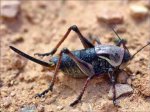MY POSTS ABOUT ETHNOZOOLOGY
7 Insec ts You’ll Be Eating in the Future
ts You’ll Be Eating in the Future
Link to Livescience article about some commonly eaten insects, their potential for higher future consumption, and a recent million-dollar award to a start-up selling grasshopper flour.
TED Talk: Why Not Eat Insects?
Not Eat Insects?
Link to TED lecture on the many benefits of entomophagy: better health, sustainable meat with less emissions/environmental impact, and yes, even for taste.
Russians P ut Frog in Milk to Prevent Spoilage
ut Frog in Milk to Prevent Spoilage
Link to scientific study of many antimicrobial compounds found in the common frog’s (Rana temporaria) skin. The study was inspired by the old practice of Russians to put a frog in milk to keep it fresh.
Bug Honeydew was a Sweet Treat for California Indians
Honeydew was a Sweet Treat for California Indians
About aphids and related sap-feeding insects, how they produce a sweet nectar, and how California Indians collected this sugar, processed it, and used it for a tasty food.
Harvester A nts (Pogonomyrmex sp.) Used as Ritual Hallucinogen by California Indians
nts (Pogonomyrmex sp.) Used as Ritual Hallucinogen by California Indians
The strange, unique use of harvester ants’ powerful sting to induce hallucinations for vision or power quest rites of passage (and also as medicine) by Indians of the California deserts.
Cricket Hunt ing Method of Nevada Indians
ing Method of Nevada Indians
How Indians of the Nevada desert harvested crickets in massive quantities with group hunts, and the importance of crickets in their diet.
Account of enjoying my hunting trip without any kills. Some gathering of plants, nice photos, and an enjoyable camping experience were all I took.
Story about finding a ringtail cat killed on a highway, seeing it’s live brethren, and about the cave they led me to.
All about the dogs of pre-settlement American Indians; their history, behavior, appearance, varieties, and many different uses.
Grizzly and other bear’s biology, ecology, biogeography, and brief history of human interaction in North America. Account of grizzly hunting/killing techniques practiced by Indians and Spanish colonists.
Story about giant walking sticks on a tiny island near New Zealand; how they were thought extinct, were re-discovered, and are being recovered.
DEFINITION
Ethnozoology is “the study of local knowledge of fauna, and the culturally mediated relationships between communities of people and the other animals of their environment” (Hunn 2011). Though as ancient as ethnobotany, ethnozoology got off to a slower start as a modern science, with the first complete ethnoozoologies written in the first half of the 1900’s, and these concentrated on a single taxon (Anderson 2011). Few studies describe local tribal ethnozoology (Anderson 2011). Many studies focus on hunting and animism (Hunn 2011). Zooarchaeology or paleoethnozoology is studied with much the same methods of paleoethnobotany (Anderson 2011). Ethnoentomology is a subfield that has been historically dominated by edible insect studies (e.g. Bodenheimer 1951, Ruddle 1973), but including modern linguistic-based studies (e.g. Wynman and Bailey 1964) (Hunn 2011).
Anderson, E. N. Ethnobiology: overview of a growing field. In Anderson, E. N., D. M. Pearsall, E. S. Hunn, and N. J. Turner (eds.). 2011. Ethnobiology. Wiley-Blackwell, Hoboken, NJ.
Bodenheimer, F. S. 1951. Insects as human food, a chapter of the ecology of man. Dr. W. Junk, Publishers, The Hague.
Hunn, E. S. Ethnozoology. In Anderson, E. N., D. M. Pearsall, E. S. Hunn, and N. J. Turner (eds.). 2011 Ethnobiology. Wiley-Blackwell, Hoboken, NJ.
Wyman, L.C., and F.L. Bailey. 1964. Navajo indian ethnoentomology. University of New Mexico Press, Albuquerque, NM.

 ting… Good Photos
ting… Good Photos
 merican Dogs
merican Dogs y Hunting
y Hunting Live!
Live!